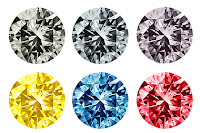Diamond Facts
The first diamonds were mined in India over 2800 years. The diamonds that we find today are all very old. In fact, most are 900 million years old or more, with the oldest known diamond being 3.2 billion years old. Like snowflakes, each diamond unique. No two diamonds are exactly the same.
There are several things to consider when learning buying diamond, and you should never rush into buying a diamond without first having done a little research on how diamonds prices.
The “4 C's”
Everyone has many things to consider when determining how to buy a diamond. Throughout the world, jewelers use of "four Cs" as a way to describe the value of a diamond. If you want to learn to buy a diamond or Buy Diamonds Online, you must learn what the 4Cs is, and how each part affects the value of a diamond.
4Cs is cut, clarity, carat and color.
How to Buy a Diamond based on the court:
The cut of a diamond describes how an artisan angles the gemstone to best reflect light through the diamond, causing it to sparkle. A quality cut brings out the beauty of a diamond and makes it more valuable, while the poor cut diamond will sell for less because it is not as bright or brighter.
How to Buy a Diamond based on Clarity:
The clarity diamonds refers to how the diamond is clear when you look through it. A perfect diamond is rare; most have inclusions and flaws, although many can not be seen without magnification. When you look at a diamond for clarity, see if there are dark spots inside the diamond.
How to Buy a Diamond based on Carats:
Larger diamonds prices more than smaller diamonds, even if the size of carats and diamonds are the same. For example, no one carat diamond costs more than three diamond rings, for a total carat. This is because larger diamonds are rarer to find. When diamonds are cut, they lose about half the size.
How to Buy Diamond by color:
The actual color of a GIA diamonds is a personal preference. But diamonds are colorless, known as white diamonds are the rarest and therefore cost more. Diamonds also come in different colors such as yellow, green, blue and pink, for example.
Certificates and Appraisals
In addition to understanding what to look for in regards to the 4 C's when learning how to buy a diamond, you should also learn how to read certified Diamonds details about the uncounted diamond and perhaps have any diamond you are interested in professionally appraised by an independent organization. You may not want to accept the appraisal done by the jeweler for the simple fact that they are biased and may appraise the diamond for slightly higher than it's actual worth in order to gain more money for the sale of the diamond.
The first diamonds were mined in India over 2800 years. The diamonds that we find today are all very old. In fact, most are 900 million years old or more, with the oldest known diamond being 3.2 billion years old. Like snowflakes, each diamond unique. No two diamonds are exactly the same.
There are several things to consider when learning buying diamond, and you should never rush into buying a diamond without first having done a little research on how diamonds prices.
The “4 C's”
Everyone has many things to consider when determining how to buy a diamond. Throughout the world, jewelers use of "four Cs" as a way to describe the value of a diamond. If you want to learn to buy a diamond or Buy Diamonds Online, you must learn what the 4Cs is, and how each part affects the value of a diamond.
4Cs is cut, clarity, carat and color.
How to Buy a Diamond based on the court:
The cut of a diamond describes how an artisan angles the gemstone to best reflect light through the diamond, causing it to sparkle. A quality cut brings out the beauty of a diamond and makes it more valuable, while the poor cut diamond will sell for less because it is not as bright or brighter.
How to Buy a Diamond based on Clarity:
The clarity diamonds refers to how the diamond is clear when you look through it. A perfect diamond is rare; most have inclusions and flaws, although many can not be seen without magnification. When you look at a diamond for clarity, see if there are dark spots inside the diamond.
How to Buy a Diamond based on Carats:
Larger diamonds prices more than smaller diamonds, even if the size of carats and diamonds are the same. For example, no one carat diamond costs more than three diamond rings, for a total carat. This is because larger diamonds are rarer to find. When diamonds are cut, they lose about half the size.
How to Buy Diamond by color:
The actual color of a GIA diamonds is a personal preference. But diamonds are colorless, known as white diamonds are the rarest and therefore cost more. Diamonds also come in different colors such as yellow, green, blue and pink, for example.
Certificates and Appraisals
In addition to understanding what to look for in regards to the 4 C's when learning how to buy a diamond, you should also learn how to read certified Diamonds details about the uncounted diamond and perhaps have any diamond you are interested in professionally appraised by an independent organization. You may not want to accept the appraisal done by the jeweler for the simple fact that they are biased and may appraise the diamond for slightly higher than it's actual worth in order to gain more money for the sale of the diamond.












